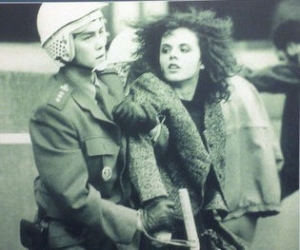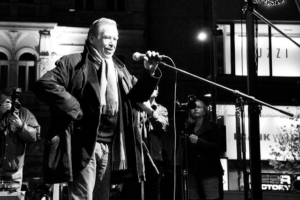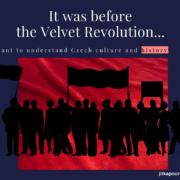It was before the Velvet Revolution…
The Velvet Revolution was a very important event in modern Czech history. Czechs often divide the new era into parts before and after the revolution. The Velvet Revolution was lasting several days and became a symbol of the end of the communist regime. Do you know when it was and why we call it „Velvet“?
Communist Czechoslovakia

Rudá hvězda, kladivo a srp – komunistické symboly
Czechoslovakia was a communist state since 1948. In February 1948 the communists staged a coup and started to govern. Czechoslovakia was a part of the Eastern (= communist) sphere (+ Poland, Hungary, Eastern Germany, Romania, Yugoslavia…). The Soviet Union became the main authority and dictated what the Czech government could or couldn´t do. Czechs couldn´t travel abroad. Censorship existed in media and literature. Secret repressive police (Státní bezpečnost) operated in Czechoslovakia. Who didn´t agree with communist politics he/she was persecuted – wasn´t allowed to do his/her profession, his/her children weren´t allowed to study, he/she could be arrested…
17th November 1989

Sametová revoluce – demonstrace na Národní třídě
Czechs protested against the regime more and more since the second half of the ’80s. They were not satisfied with the political and economical situation. On 17th November 1989, a legal manifestation of university students took place – they were walking through Prague to commemorate 17th November as international students day. Other people were joining the procession and it became a big demonstration (10 000 people) in a few hours. People wanted to go peacefully to Wenceslas square. The communist government didn´t want to reach it because the Wenceslas

Sametová revoluce – zásah policie na Národní třídě
square was a symbol of demonstrations and protests. The government called the police to take action against people. In Národní street in Prague, the police made a barrier in front and at the back so people could not leave. Officers started to beat people brutally, there were 568 injured people. Later, some of the students attended Prague theatres and told others what had happened. TV and radio also broadcasted news about the whole situation.
The Velvet Revolution

Václav Havel
A lot of demonstrations took place in the whole of Czechoslovakia during the following days. People wanted the communists to leave the government. Surprisingly, it was a fast process. The communists really stopped governing and a new, democratic government started to work. Czechs and Slovaks achieved freedom, they can democratically vote in their parliament, make private business, travel …
Except for the 17th of November when the police attacked people the revolution was peaceful, without violence, and nobody died. That´s why we call it the Velvet Revolution.
- 17th November – student´s peaceful manifestation, the police attacked people
- from 18th November – demonstrations in the whole of Czechoslovakia, organized by the official opposition party (Občanské fórum)

Sametová revoluce – plastika na Národní třídě
- 27th November – general strike in Czechoslovakia, nobody was working
- 28th November – the communists announced officially they would leave the government
- 10th December – a new, non-communist government
- 29th December – the first non-communist president Václav Havel
The international situation
Revolutions took place in the whole Eastern block of communist states. People were not satisfied with the political and economical situation in their countries. During autumn of 1989, the communist regime was over in Poland, Hungary, Romania, Bulgaria, Eastern Germany, Czechoslovakia, Yugoslavia, and the Baltic states.
Czechoslovak modern history
- 28th October 1918 – the democratic Czechoslovak Republic was founded
- 1938–1945 – Czechoslovakia was occupied by Germany
- 1945–1948 – democratic Czechoslovakia again
- 1948–1989 – communist Czechoslovakia
- 17th November 1989 – the Velvet Revolution
- since December 1990 – democratic Czechoslovakia again
- 1st January 1993 – Czechoslovakia divided into the independent Czech Republic and the Slovak Republic

Sametová revoluce – svíčky na Národní třídě
Celebrate the anniversary of our important day with us. Join the Festival of Freedom in Národní street or in the Czech and Moravian regions. Become a member of the street art festival, enjoy concerts, and many other events.
Or what about preparing a Czech typical dish? You can find super easy recipes in this cookbook.
Read also other articles about important days and moments in Czech history:
The First Republic and „Daddy“ Masaryk
17th November 2021
Photos:
Václav Havel: Pavel Matejicek / Flickr (CC BY-NC-ND 2.0)
Next: Pixabay.com, Flickr.com





Leave a Reply
Want to join the discussion?Feel free to contribute!